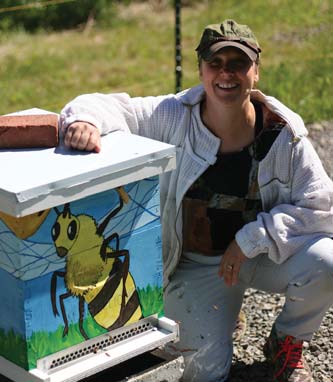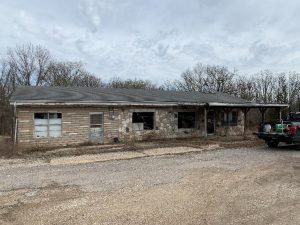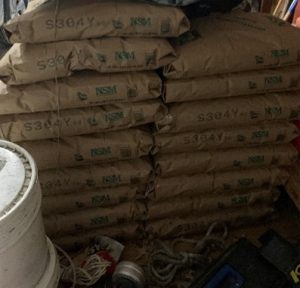By: Dr. Tracy Farone
In honor of pollinator month this June, I have decided to highlight the sylvatic side of bee medicine: Our wild bees. “Sylvatic” is a word used to describe wild animal populations and is often used in the description of disease lifecycles in wildlife populations. For example, the “sylvatic cycle” of Rabies viruses is important to understand in the prevention of the disease in domestic animal species and humans. While much of veterinary medicine is focused on the treatment of domestic animal species, veterinarians may also receive training in wildlife medicine. I had the privilege of working at a wildlife center, while I was a veterinary student at Ohio State. It was yet another experience that taught me to consider the bigger picture of how all health is connected, the environment, domestic animal species, wild animal species, and humans. To help examine this One-health relationship, as it relates to bees, I decided to do something we often do in science and medicine: consult. So, I recruited the help of a wild bee health specialist, Dr. Margarita María López-Uribe, Assistant Professor of Entomology at Penn State University to address some of the key concepts that we should keep in mind regarding our wild bee pollinators. Much of her work has focused on squash bees, bumble bees, and relationships between genetic diversity and the environment. She also assists honey bee beekeepers overcome some of the challenges they face with their operations. Over Easter Break, we sat down (over ZOOM) and discussed the sylvatic side of bee medicine. Below are some highlights from questions I posed to Dr. López-Uribe during our discussion.
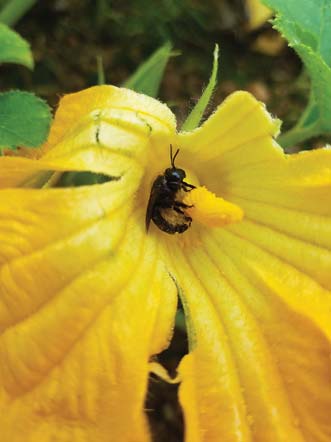
Bee shown is of the Melissodes genus, “ Long-horned” bee. Photo credit – Katy Evans
1. How many species of native pollinators in the U.S. are considered threatened/endangered?
According to Dr. López-Uribe, there are approximately 3,600 species of bees in North America. However, Dr. López-Uribe points out that, “The question of how many species are in trouble is still very much in development.” Dr. López-Uribe considers the Xerces Society to be a great resource for information on native pollinators and notes that they list 20 bee species, mostly from Hawaii, as species with populations at risk. Only one species in the continental U.S., the Rusty Patch Bumble Bee, is officially listed as endangered. Dr. López-Uribe does believe that evidence is pointing to “a drop in species richness” associated with “the homogenization of the landscape and then the domination of a handful of species that adapt well to human-modified landscapes.” However, she points out that more monitoring research is needed in this area, so we can have the data to fully understand what we may be losing in the first place.
2. Are some native pollinators managed to increase pollination of crops?
According to Dr. López-Uribe, in the U.S. only a couple of truly native, wild bee are “managed” as pollinators, including the Blue Orchard Bee and the Alkali Bee, primarily on the West Coast. Other “managed” bee pollinators, the Japanese Orchard Bee and Alfalfa Leaf-cutter Bees are wild but not native. Our discussion then included an interesting tangent on the definition of the word “native” as it is currently used with “native pollinators”. Dr. López-Uribe prefers the use of “wild” bees/pollinators, as “native” may be more and more difficult to define. For example, “squash bees” originally came from areas of Mexico and the southwest U.S. to what is now the northeastern U.S., a thousand years ago as pumpkins and squashes were cultivated in northen latitudes of North America. So, what does “native” really mean? When is the timeline in the sand drawn? I will be using “wild” instead of “native” for the rest of this article.
To further clarify terminology, certainly honey bees can go “feral”, but honey bees are best managed as domesticated, agricultural animals and are not considered “wild” (or native to the Western Hemisphere). During the discussion, we also discovered that we both use cats as an analogy to honey bees, in that cats are a domestic species, who can also live ferally, but like honey bees, this situation is not best for the health of the animal, native wildlife, or the environment.
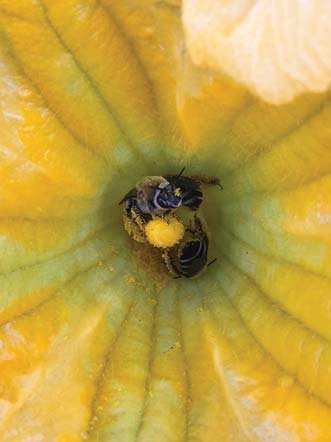
Peponapis is a genus of solidary bees. Photo credit: Dr. Lopez-Uribe
3. How does your work promote the health of wild pollinators?
In addition to providing education about “real problems with pollinators” through many lectures and writings, Dr. López-Uribe’s lab is currently investigating the medical ecology of pollinators and the possibility of “any spillover of pathogens” between bee species. There certainly is interest to see if honey bees and wild bee populations can transmit disease back and forth and/or act as reservoirs for pathogens. At this point, Dr. López-Uribe says, “While pathogens are everywhere . . . There is no good evidence yet that honey bees’ pathogens are doing anything terribly bad to solitary bees – like the squash bee. Bumble bees are the exception. We know that bumble bees share a lot of pathogens with honey bees, and that bumble bees can get sick when infected with honey bee pathogens” One interesting finding from recent papers from Scott McArt and her lab suggest that more flowers in a landscape can actually dilute pathogens. Dr. López-Uribe states that “increased floral diversity and abundance may cause a dilution of pathogens on flowers, which will lower the pathogen pressure on all species.” This research points to the environment as a plausible solution for decreasing disease threats for both wild bees and honey bees.
4. What health concerns do you have for wild pollinators? Infectious diseases? Parasites? Pesticides? Nutrition?
Dr. López-Uribe considers nutrition to be “likely the single most limiting factor” for wild bee health. She also believes this is the potential “point of conflict” between conservationists and honey bee keepers, as competition for floral resources between honey bees and wild pollinators can be a difficult fight for wild pollinators to win. The small colony size of social native bee species or the solitary lifestyle of wild bees may make it difficult to compete in areas saturated with honey bee colonies boosting tens of thousands of foragers. Honey bees also have beekeepers that can feed them when natural forage runs low. Dr. López-Uribe points out “wild bees don’t have beekeepers to feed them.” Limiting honey bee colony numbers per area can help level the playing field for wild bees. Dr. López-Uribe also states that loss of habitat has played a large role in nutritional challenges for all bees.
While both honey bees and wild bees are exposed to pesticides, Dr. López-Uribe considered two things that may make wild bees more sensitive to pesticides compared to honey bees. She explained, “Wild bees have solitary lifestyles – feeding of brood is much more direct – leading to potential increased pesticide exposure of larvae. (Secondly), many wild bees nest in the ground . . . and studies have shown that pesticide exposure through soil can be very high.”
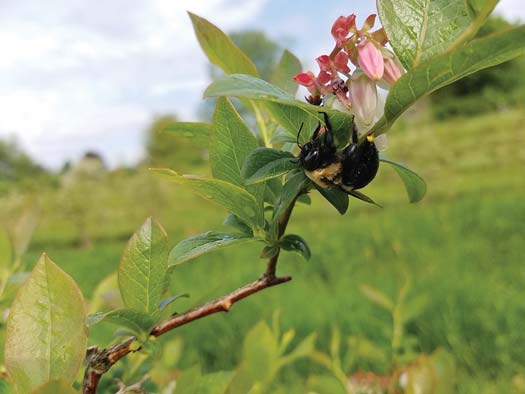
A Carpenter Bee. Photo credit Katy Evans
Regarding diseases, there is some good news but also much more to learn. The good news: Varroa does not involve wild bees, however, some viruses like Deformed Wing Virus, (DWV), has been found in several wild pollinators including bumble bees, solitary bees, and flies. Nosema, Crithidia, Apicystis, and Spiroplasma are among the other “pathogens” identified in wild bees, but according to Dr. López-Uribe, the real question is: “Are wild bees actual hosts?” These potential honey bee pathogens have not been shown to cause severe disease in solitary wild bees even though they can replicate in some species. Dr. López-Uribe emphasized the need for more disease research to provide solid evidence of the fitness costs of honey bee pathogens on wild solitary bees.
5. Honey bees get lots of credit for crop pollination. How important are wild pollinators to pollination of our crops?
Backed by plenty of strong science, Dr. López-Uribe emphasized “If you want to maximize crop pollination in large agricultural systems, you need wild bees and managed bees like honey bees.” Here is where wild bees and honey bees can really work together. Honey bees are largely effective due to the large numbers of foragers working the land and our ability to place them anywhere (for example, in the middle of a farm). Overall, wild bees are often more effective pollinators on a per visit basis. Think of a big, super fuzzy bumble bee working a flower, compared to the sleek honey bee! Dr. López-Uribe explained that these different behavioral approaches to working flowers demonstrate how domesticated and wild species can have very complementary relationships, especially in large acreage of monoculture where wild bees may only benefit crop flowers at the edge of fields. Diversity of plantings and larger portions of natural habitat within farms can be used to attract more wild pollinators to supplement honey bee pollination.
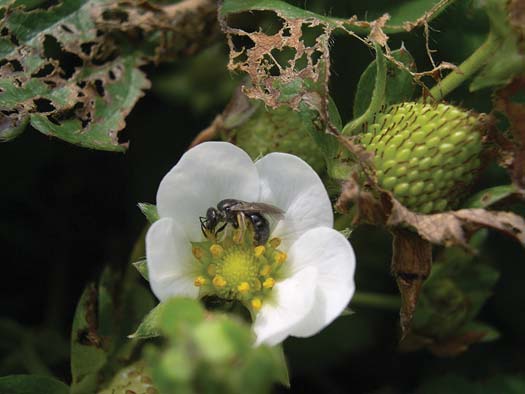
A sweat bee. Photo credit Kathy Demchak
6. What would you like honey bee beekeepers to understand to promote wild bee health?
Dr. López-Uribe emphasized two main points for honey bee beekeepers or potential honey bee beekeepers that she believes are critical to understand. First, “honey bees are an outlier to the biology, behavior – everything compared to other bees, and they often compete for the same floral resources.” Secondly, she accentuated, “We do need to understand that honey bees are domesticated animals that need food, care, treatments. This takes training, equipment and understanding.” She believes the challenge is to get past the “save the bees, romantic idea and that buying a (honey) bee colony is helping – when in fact you may not be helping anyone – by introducing honey bee hives to an area and not taking good care of the colony you may actually be just trashing the environment and spreading pathogens.” Her advice to new beekeepers is to be sure you are being “a good steward of the environment” by being sure you have enough knowledge and forage/flowers/habitat for your colony before considering getting one. Ultimately, better understanding the balance of relationships between our domesticated species and wild species with our environment will lead to the best health of all pollinators.




